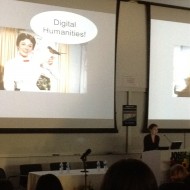SIBMAS-TLA Conference: Nic Leonhardt Keynote
I knew when the morning began with Daft Punk’s “Technologic” we were in for an interesting session. Thursday marked the SIBMAS-TLA conference’s session dedicated to Digital Humanities and the Performing Arts, hosting an interesting array of case studies, projections, and vendor perspectives on what Digital Humanities means and where libraries lie in the discipline.
Nic Leonhardt kicked off the day with her keynote discussing the various ways in which we have come to define digital humanities, or DH, pairing that discussion with a litany of projects that have emerged in various performing arts fields and libraries. While she did not delve much into her own projects, Transatlantic Theatrical Networks and Theatrescapes, which are definitely worth a look, she did identify projects headlined by libraries and archives, as well as those spearheaded by the respective humanities disciplines themselves.
Some may just be catching on to the buzz term, but Leonhardt has already identified a second wave of DH that we are now entering. Early in its academic conceptions, digital humanities focused on the digital accessibility of the physical, encompassing large digitization projects for still images, audio, video, and everything and anything else. Unfortunately, for many of these projects, there was no larger goal involved, and their initiatives were either lost in the flood, or never made it to shore.
Now, many DH projects are taking the large amounts of information and media made available in the first wave and are looking to take qualitative approaches for analysis. We do not just have images of Shakespeare’s Theatres, but a map that places them in context of London with Mapping Shakespeare’s London. Not only can we see a simulation of a Vaudeville performance through Virtual Vaudeville, but also how the audience would have reacted in the late 19th and early 20th centuries
At the same time that Leonhardt identified “DH 2.0,” she suggested that digital humanities is only a preliminary term, and though it has been around for a few years, we still need to redefine its aims to link and collaborate between digital initiatives and traditional humanities disciplines. If anything, digital humanities is a launching board into e-humanities, or “enhanced humanities;” DH did not invent collaborative research, but facilitates it between two communities that had yet to cross paths.
With the last day of the SIBMAS-TLA conference focusing on material culture and ephemera, Nic Leonhardt’s keynote on Digital Humanities could not have been a more perfect lead-in. While there is something to be said of experiencing the physical, digital humanities projects provide the perfect means for access as well as exposure and analysis. As academic liaisons and as the storehouses of so much physical archives and ephemera, librarians and libraries are in the perfect position to get involved with digital humanities, and need to not only ride the wave but create waves of their own.
Emily Witkowski
Rutgers University

